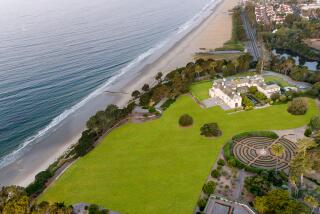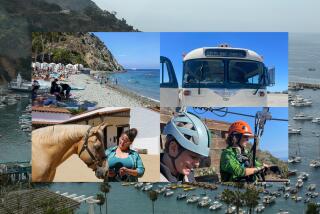Rooms With a View to Laguna’s Past
Roger W. Jones is an engineer running an electronics-related firm who never gave much thought to writing a book, let alone two books. It began when he fell in love with a house he could not afford to own. . . .
It’s a magnificent mansion by the sea. It’s made of bricks and stone, with huge cedar beams throughout, with steps winding down its rock cliff to its own private cove. Villa Rockledge, in the heart of Laguna Beach’s coastline, was built in the 1920s by Frank Miller, who also owned Riverside’s Mission Inn.
In his single days, before his career took off, Jones was a tenant paying $125 a month in one of Villa Rockledge’s guest cottages, just up the cliff from the main house. When the estate went on the market in the early 1970s, he tried to put a deal together to buy it but lacked the money. In 1973, he finally bought it for $420,000. His only hope was keeping the seven guest units rented out to pay the mortgage.
“I thought if I went broke, now was the time, while I was still young,” Jones said. “I just had to have this house, to restore it to its original beauty.”
As Jones’ career took off, he poured most of his money into Villa Rockledge. Owners over the years had plastered over Miller’s beautiful wood beams for lower ceilings. Jones has managed to undo the damage in almost every room.
Jones got Villa Rockledge listed on the national historic registry and decided it deserved its own book, which he wrote late at night after his wife and their two sons had gone to bed. “The History of Villa Rockledge” is a thin but delightful volume if you happen to be interested in the history of great homes, which I am.
But Jones’ research on his own house only whetted his appetite to learn more about local history.
“We really don’t get enough about it in school,” he said. “We know all about Columbus, but we learn little about Cortes. What Cortes did was phenomenal.”
So Jones spent his spare time researching and his late nights writing. The result is a huge, new coffee table book ($75) called “California, from the Conquistadores to the Legends of Laguna.” A little Villa Rockledge is thrown in too.
You can find it in bookstores in the county’s coastal cities. Because of its price, Jones doesn’t expect to sell copies in large numbers.
“It was a labor of love,” he said. “Maybe it will spur somebody’s interest in California history.”
The first half of the book contains detailed accounts of Spanish conquests of Mexico and Hernando Cortes’ explorations of Southern California. It expands from there to take in Southern California’s growth over the last few centuries.
The book is loaded with pictures of Laguna in its infancy, before its hills became dotted with homes.
I especially enjoyed some of the remembrance letters, stories told or given to Jones. For example, if you weren’t around for the great Laguna tidal wave of 1918, perhaps you’ve heard your parents or grandparents talk about it. Esther Sharp lived alone in Laguna in a beachfront home with her baby daughter, Virginia, at the time; her husband was overseas with the Secret Service. After her daughter was grown, she wrote her a letter about the tidal wave, quoted here in part:
“The house began to shake and the waves started piling in. It continued for hours and hours. By afternoon I had you packed in your baby carriage, ready to take off somewhere up in the hills. . . . For blocks and blocks around there was only one other house.”
Esther Sharp writes that she and her daughter made it to safety just before the waves crossed what is now Pacific Coast Highway, flooding the small downtown. “If there had been any people around where I could just go in and sit for a few minutes, I wouldn’t have been so scared. But all alone and half sick, it just got to me.”
Laguna surely was a paradise to behold in those years. Even before the days of motels, though, it was quite a tourist attraction. Has anyone been around long enough to remember the tent cities along the beach? They were set up at the turn of the century. There was one at Broadway and Coast Highway in downtown Laguna, another at Aliso Beach. Jones has pictures of them in his book.
“Good floors and iron beds,” one of them advertised about its tents. You could rent one for four people for $14 a week. A pup tent cost a dollar a day. And if you just wanted a spot to sleep on your own, you could hang out there for 50 cents a day.
The book includes many marvelous photos of old Laguna. There’s one of Eiler Larson, the unofficial town greeter, who could be seen almost daily for years welcoming visitors who arrived by Pacific Coast Highway. If you don’t remember Larson, who died in 1975, I’m sure many of you have seen the statue of him. It sits just outside Laguna’s Pottery Shack along PCH.
We can never return to those days, but it’s fun to look back. And one more book helping us do that, with both stories and photos, is a welcome addition to the county’s historical collection.
Wrap-Up: The first thing you notice looking out at the rock cove from the terrace at the Villa Rockledge is what you don’t see: No footprints in the sand. Because of the arch of rocks at each border, Villa Rockledge’s beach is completely secluded.
Jones gave me a tour of the grand old house, where you get ocean views from almost every room. The crashing waves, Jones said with a smile, make it a peaceful place to live.
Jones no longer lives in the main house at Villa Rockledge. He and his wife, Sherill, moved to Newport Beach so their sons would be less isolated from friends. But they plan to return as soon as their younger son finishes high school in another three years. By then, Jones hopes to have the restoration completed.
Though the house is now worth well into seven figures, Jones vows he will never sell. He shudders at recalling how someone had once offered to buy the house with him in order to tear it down and build three new homes.
“I’m just the caretaker for this piece of history,” Jones said. “It’s with me until it’s time for it to go to someone else who will care about it.”
Jerry Hicks’ column appears Tuesday, Thursday and Saturday. Readers may reach Hicks by call-ing the Times Orange County Edition at (714) 966-7823 or by fax to (714) 966-7711, or e-mail tojerry.hicks@latimes.com
More to Read
Sign up for The Wild
We’ll help you find the best places to hike, bike and run, as well as the perfect silent spots for meditation and yoga.
You may occasionally receive promotional content from the Los Angeles Times.






